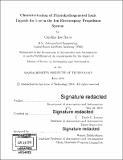| dc.contributor.advisor | Paulo C. Lozano. | en_US |
| dc.contributor.author | Bates, Caroline Lee | en_US |
| dc.contributor.other | Massachusetts Institute of Technology. Department of Aeronautics and Astronautics. | en_US |
| dc.date.accessioned | 2018-11-15T16:34:48Z | |
| dc.date.available | 2018-11-15T16:34:48Z | |
| dc.date.copyright | 2018 | en_US |
| dc.date.issued | 2018 | en_US |
| dc.identifier.uri | http://hdl.handle.net/1721.1/119058 | |
| dc.description | Thesis: S.M., Massachusetts Institute of Technology, Department of Aeronautics and Astronautics, 2018. | en_US |
| dc.description | Cataloged from PDF version of thesis. | en_US |
| dc.description | Includes bibliographical references (pages 63-65). | en_US |
| dc.description.abstract | This thesis investigates the use of two fluorohydrogenated ionic liquids as propellants for the ion Electrospray Propulsion System developed at MIT, 1-ethyl-3-methylimidazolium fluorohydrogenate and trimethylsulfonium fluorohydrogenate. It was found that these ionic liquids undergo a crystallization-like transformation when exposed to vacuum for several hours. Mixtures with a vacuum stable ionic liquid (1-ethyl-3-methylimidazolium trifluoro(trifluoro methyl)borate) were made to study the onset of this transformation and to obtain liquid mixtures from which stable electrospray emission could be obtained. Mixtures containing 10%, 25%, or 50% by mass of one of the fluorohydrogenated ionic liquids are then investigated using time of flight mass spectrometry to determine the beam compositions. All six mixtures operate in the pure ionic regime. Of the six mixtures, the mixture of 25% trimethlysulfonium fluorohydrogenate is the best candidate for use as propellant in the ion Electrospray Propulsion System, because it produces current 4.8 times higher than pure 1-ethyl-3-methylimidazolium trifluoro(trifluoro methyl)borate, and the beam is composed entirely of monomers. Additionally, at voltages used for the ion Electrospray Propulsion System, the 25% trimethlysulfonium fluorohydrogenate mixture has an increase in specific impulse up to 2,000 s over pure 1-ethyl-3-methylimidazolium trifluoro( trifluoro methyl)borate. In the appendix, an application of the ion Electrospray Propulsion System is investigated, namely the new WaferSat femtosatellite being developed at MIT Lincoln Laboratory. Motion simulations give preliminary insights into how WaferSats will move in orbit. | en_US |
| dc.description.statementofresponsibility | by Caroline Lee Bates. | en_US |
| dc.format.extent | 65 pages | en_US |
| dc.language.iso | eng | en_US |
| dc.publisher | Massachusetts Institute of Technology | en_US |
| dc.rights | MIT theses are protected by copyright. They may be viewed, downloaded, or printed from this source but further reproduction or distribution in any format is prohibited without written permission. | en_US |
| dc.rights.uri | http://dspace.mit.edu/handle/1721.1/7582 | en_US |
| dc.subject | Aeronautics and Astronautics. | en_US |
| dc.title | Characterization of fluorohydrogenated ionic liquids for use in the ion electrospray propulsion system | en_US |
| dc.type | Thesis | en_US |
| dc.description.degree | S.M. | en_US |
| dc.contributor.department | Massachusetts Institute of Technology. Department of Aeronautics and Astronautics | |
| dc.identifier.oclc | 1057726058 | en_US |
